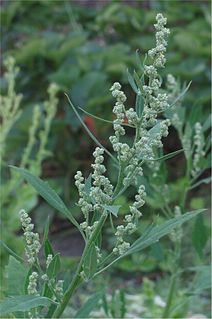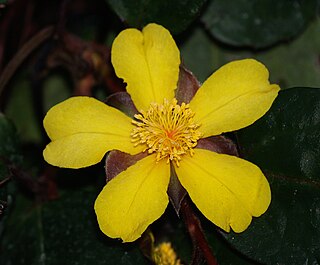
Chenopodium album is a fast-growing weedy annual plant in the genus Chenopodium.

Magnolia campbellii, Campbell's magnolia, is a species of Magnolia that grows in sheltered valleys in the Himalaya from eastern Nepal, Sikkim and Assam, India, east to southwestern China and south to northern Myanmar.

Prunus serrulata or Japanese cherry, also called hill cherry, oriental cherry, East Asian cherry, Tai-haku, or Taihaku, is a species of cherry native to China, Japan, Korea, and India, and is used for its spring cherry blossom displays and festivals. Current sources consider it to be part of a species complex with P. jamasakura and P. leveilleana, which have been reduced to synonyms.

Caladium is a genus of flowering plants in the family Araceae. They are often known by the common name elephant ear, heart of Jesus, and angel wings. There are over 1000 named cultivars of Caladium bicolor from the original South American plant.

Hoya carnosa, the porcelainflower or wax plant, is an Asclepiad species of flowering plant in the dogbane family Apocynaceae. It is one of the many species of Hoya that are native to Eastern Asia and Australia. It is a common house plant grown for its attractive waxy foliage, and sweetly scented flowers. It is grown well in pots and hanging baskets.

Canna indica, commonly known as Indian shot, African arrowroot, edible canna, purple arrowroot, Sierra Leone arrowroot, is a plant species in the family Cannaceae. It is native to much of South America, Central America, the West Indies, Mexico, and the southeastern United States. It is also naturalized in much of Europe, sub-Saharan Africa, Southeast Asia, and Oceania. Canna indica has been a minor food crop cultivated by indigenous peoples of the Americas for thousands of years.

Hibbertia dentata, commonly known as toothed guinea flower, trailing guinea flower or twining guinea flower, is an ornamental plant in the family Dilleniaceae native to the east coast of Australia. Found in woodland, it is a trailing or twining vine with leaves with several small 'teeth' on the margins and bright yellow flowers in early spring. It adapts readily to cultivation and can be grown as a pot plant. The species was first described in 1817.

Eucrosia aurantiaca is a species of plant which is endemic to Ecuador. Its natural habitats are subtropical or tropical dry forests and subtropical or tropical dry shrubland. It is threatened by habitat loss.

Eucrosia is a genus of herbaceous, perennial and bulbous plants in the Amaryllis family distributed from Ecuador to Peru. The name is derived from the Greek eu, beautiful, and krossos, a fringe, referring to the long stamens. The genus contains eight species. Phaedranassa and Rauhia are the genera most closely related to Eucrosia.
Eucrosia dodsonii is a species of plant that is endemic to Ecuador. Its natural habitat is subtropical or tropical moist montane forests. It is threatened by habitat loss.
Eucrosia stricklandii is a species of plant which is endemic to Ecuador. Its natural habitats are subtropical or tropical dry forests and subtropical or tropical dry shrubland. It is threatened by habitat loss.

Gazania rigens, sometimes called treasure flower, is a species of flowering plant in the family Asteraceae, native to southern Africa. It is naturalised elsewhere and is widely cultivated as an ornamental plant.

Paeonia delavayi is a low woody shrub belonging to the peonies, that is endemic to China. The vernacular name in China is 滇牡丹, which means "Yunnan peony". In English it is sometimes called Delavay's tree peony. It mostly has red brown to yellow, nodding flowers from mid May to mid June. The light green, delicate looking deciduous leaves consist of many segments, and are alternately arranged on new growth.

Paeonia ludlowii, is a medium high, deciduous shrub, belonging to the peonies, that is endemic to South-East Tibet. In Tibet it is known as lumaidao meaning "God’s flower". The vernacular name in China is 大花黄牡丹 meaning "big yellow-flowered peony". In English it is sometimes called Tibetan tree peony or Ludlow's tree peony. It has pure yellow, slightly nodding, bowl-shaped flowers, and large, twice compounded, light green leaves.
Eucrosia eucrosioides is a species of plant that is found in south west Ecuador and north Peru. Its natural habitats are seasonally dry lowland areas.
Eucrosia mirabilis is a species of plant from Ecuador. In the original scientific description in 1869, it was believed to be from Peru, but there is little evidence it ever grew there. The plant disappeared from cultivation until it was found in Ecuador in 1997. Its natural habitats are seasonally dry lowland areas to elevations of 1500 m.
Eucrosia tubiflora is a species of plant which is endemic to Peru.

Pittosporum bicolor, commonly known as cheesewood or banyalla, is a flowering shrub or small tree of the Pittosporaceae family, and is native to south eastern Australia.

Roscoea cautleyoides is a perennial herbaceous plant occurring in the Sichuan and Yunnan provinces of China. The scientific name is also spelt Roscoea cautleoides. Most members of the ginger family (Zingiberaceae), to which it belongs, are tropical, but R. cautleyoides, like other species of Roscoea, grows in much colder mountainous regions. It is sometimes grown as an ornamental plant in gardens.

Gasteria bicolor is a species of succulent flowering plant in the family Asphodelaceae, native to the Eastern Cape, South Africa.















